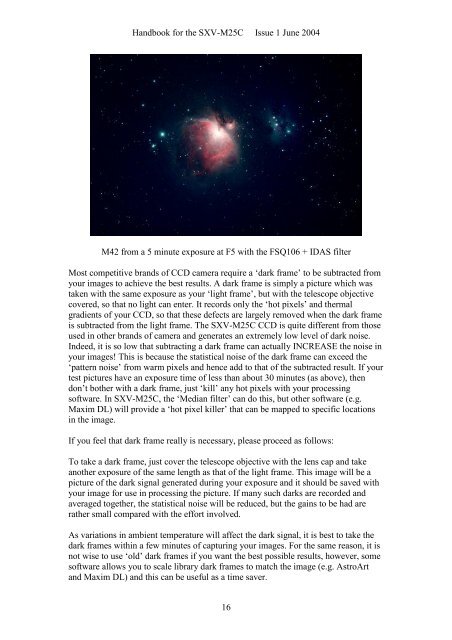SXVF-M25C handbook - Starlight Xpress
SXVF-M25C handbook - Starlight Xpress
SXVF-M25C handbook - Starlight Xpress
Create successful ePaper yourself
Turn your PDF publications into a flip-book with our unique Google optimized e-Paper software.
Handbook for the SXV-<strong>M25C</strong> Issue 1 June 2004<br />
M42 from a 5 minute exposure at F5 with the FSQ106 + IDAS filter<br />
Most competitive brands of CCD camera require a ‘dark frame’ to be subtracted from<br />
your images to achieve the best results. A dark frame is simply a picture which was<br />
taken with the same exposure as your ‘light frame’, but with the telescope objective<br />
covered, so that no light can enter. It records only the ‘hot pixels’ and thermal<br />
gradients of your CCD, so that these defects are largely removed when the dark frame<br />
is subtracted from the light frame. The SXV-<strong>M25C</strong> CCD is quite different from those<br />
used in other brands of camera and generates an extremely low level of dark noise.<br />
Indeed, it is so low that subtracting a dark frame can actually INCREASE the noise in<br />
your images! This is because the statistical noise of the dark frame can exceed the<br />
‘pattern noise’ from warm pixels and hence add to that of the subtracted result. If your<br />
test pictures have an exposure time of less than about 30 minutes (as above), then<br />
don’t bother with a dark frame, just ‘kill’ any hot pixels with your processing<br />
software. In SXV-<strong>M25C</strong>, the ‘Median filter’ can do this, but other software (e.g.<br />
Maxim DL) will provide a ‘hot pixel killer’ that can be mapped to specific locations<br />
in the image.<br />
If you feel that dark frame really is necessary, please proceed as follows:<br />
To take a dark frame, just cover the telescope objective with the lens cap and take<br />
another exposure of the same length as that of the light frame. This image will be a<br />
picture of the dark signal generated during your exposure and it should be saved with<br />
your image for use in processing the picture. If many such darks are recorded and<br />
averaged together, the statistical noise will be reduced, but the gains to be had are<br />
rather small compared with the effort involved.<br />
As variations in ambient temperature will affect the dark signal, it is best to take the<br />
dark frames within a few minutes of capturing your images. For the same reason, it is<br />
not wise to use ‘old’ dark frames if you want the best possible results, however, some<br />
software allows you to scale library dark frames to match the image (e.g. AstroArt<br />
and Maxim DL) and this can be useful as a time saver.<br />
16

















